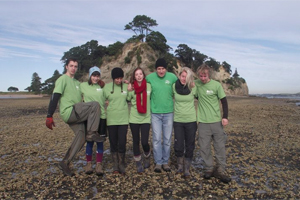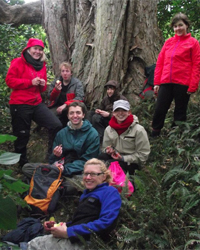
Morning: Each morning I and the other volunteers would wake up early, make a quick breakfast (which usually consisted of yogurt, eggs, cereal-WeetBix was the famous New Zealand brand, toast, fruit, and other healthy options, and meet at the woolshed close by our house. The volunteer leaders would then describe the day's activities they had scehduled which usually included planting, weeding, beach cleanups, and trail maintenance with tea breaks and a long lunch break at a certain hour. If there was more than one job to do at a time, we would divide our seven person volunteer group into 2 or 3 and split up across the island.
Afternoon: Afternoons were spent working, usually out of the woolshed on the other side of the island. The weather was very nice at this time of the day and though we did accomplish a lot, the work was laid back and even relaxing. It was easy to be scouting for weeds and suddenly find yourself isolated in nature from the rest of the group, which I found really nice. Surprisingly frequent rainbows and double rainbows made this time even more tranquil and the sight even more beautiful.

Evening: Evenings were spent back at home with the volunteers hanging out, making dinner (we made a lot of pasta, burgers and veggie burgers, stir fry, and nachos), and included the occasional discussion. These discussions were run by our volunteer leader and focused on living a sustainable lifestyle and how we could continue to do that when we returned home. We also played many different card games and sometimes went on night hikes around the island. I got to know many of my now best friends when we did this, and is one of my favorite parts of the trip when I look back on it.
Highlights: The highlight of my trip would definitely be getting to live on Motuihe while we volunteered. Aside from myself, the other volunteers, our leaders, and a park ranger, the island was human-free. It is not often that I have been able to experience nature like this-amazingly diverse tidal pools, forests, and wildlife (including the tuatara!), and they were all very healthy communities. Our leader taught us an overview of the ecology of the area and many interesting facts about the animals that lived there. This made me understand the positive impacts our work was having on the island and made me more motivated and involved in the restoration work.